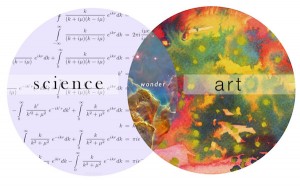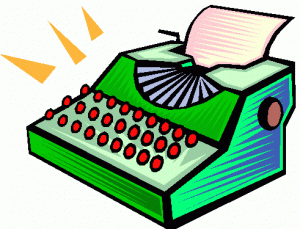The Art of Science and the Science of Art: Writing
Last week, I started a new series of posts on the overlap of my two favorite topics: art and science. After discussing the similarities and differences between artistic and scientific reading, today I’d like to talk about the next major aspect of this creative intersection: writing. How do art and science compare when it comes to composition? Let’s explore!
How the Art is like the Science

At the intersection of Art and Science lies Wonder. – The Imaginary Foundation
When thinking about what art and science have in common, one of the first similarities to come to mind is the written word. Ideas of any kind are often best communicated through writing, so it’s important to know how to convey one’s thoughts as eloquently as possible. As I previously mentioned about reading, our minds have learned to make sense of prose through a set order, and writers of fiction and non-fiction alike must respect that order if their work is to be understood.
Whether we write artistically or scientifically, we have to know how to grab our readers and hold their interest throughout a given work. A good title will attract an audience that shares our interests. The introductory portion establishes our style and the main idea of the whole piece. We must include a clear objective and the promise of action by the middle of the work, and that action must lead to a resolution of conflict by its conclusion. In art and science alike, everything we write must somehow tie together in the end.
Much like reading, writing is fundamentally the same whether it’s done artistically or scientifically. Yet art and science also differ greatly, and in my opinion, nowhere do these disparities shine brighter than in their composition.
How the Art is unlike the Science
When we write artistically, we have all the freedom in the world to experiment with words and ideas to turn out an interesting piece. We can write about anything from magic and myth to true events in history. We can start in the middle and halfway through jump back to the beginning. We can elaborate on the tiniest details or leave everything but plot up to the reader’s imagination. We can write themes and endings that are either thoroughly conclusive or open to interpretation. The possibilities are endless.
 The same freedoms generally don’t apply to science, however. Because academic papers all have to be comprehensible in the same manner, they come with strict rules and guidelines for how to write them. That isn’t to say that we can’t be creative at all, of course; just that there are far more restrictions to work with than in artistic writing. We’re more than welcome – even encouraged – to demonstrate creative thinking, as long as it’s presented with a title, an abstract, an introduction, materials and methods, results, a discussion, and a conclusion. When the point is to convey our ideas as clearly as possible, organization is key.
The same freedoms generally don’t apply to science, however. Because academic papers all have to be comprehensible in the same manner, they come with strict rules and guidelines for how to write them. That isn’t to say that we can’t be creative at all, of course; just that there are far more restrictions to work with than in artistic writing. We’re more than welcome – even encouraged – to demonstrate creative thinking, as long as it’s presented with a title, an abstract, an introduction, materials and methods, results, a discussion, and a conclusion. When the point is to convey our ideas as clearly as possible, organization is key.
Writing prose is both an art and a science at its core, so it’s up to the writer to master the balance between these approaches and know how to make the most of their individual strengths to turn out truly creative works. And that is exactly what I love about creative writing: it appeals to both the artist and the scientist in me! I sincerely hope you can appreciate this beautiful intersection of art and science as much as I do! Thanks for reading!


Recent Comments